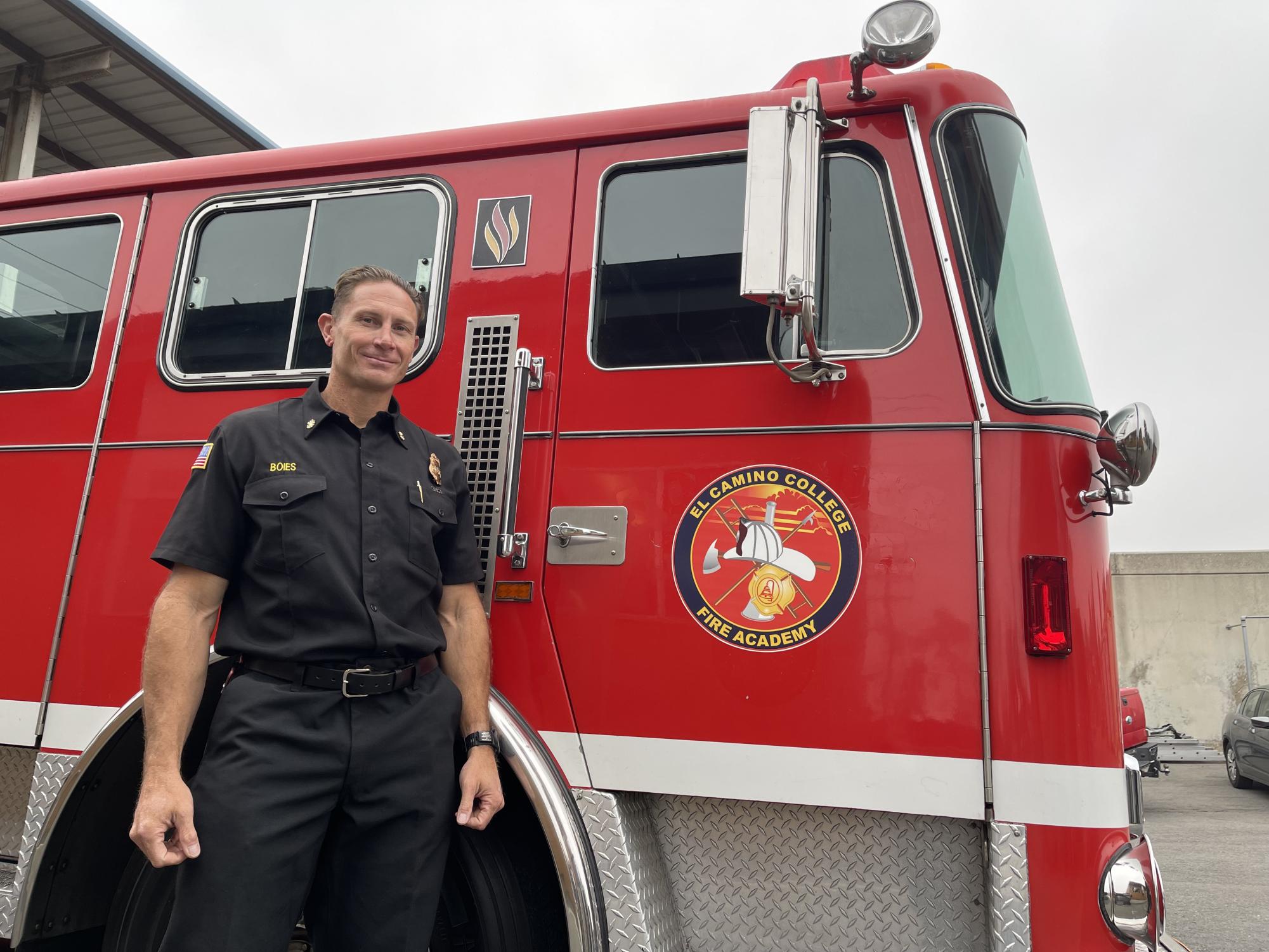With human-caused climate change increasing temperatures, decreasing rain and snowfall, and escalating the frequency and severity of storms and wildfires, Southern California’s four seasons are now fire, flood, mud and drought.
Here are five ways professors and programs at El Camino are supporting students, staff and faculty to beat the heat.
Prepare and protect first responders
Climate change has increased the occurrence, length and intensity of fires as well as fire season.
A report by Climate Central tracked higher levels of heat, dryness and wind over five decades as the leading contributors to the dramatic escalation in wildfire emergencies throughout the Western United States, most notably in California.
At the El Camino Fire Academy, instructors are preparing students for the extreme physical and emotional stress caused by increasing demands on firefighters.
To teach fire abatement, “We make the students hike in, cut fire lines, clear trails. We run it like a real incident, put them through real scenarios,” said Chief Josh Boies, fire academy director.
The majority of El Camino firefighting instructors work with fire departments throughout California, and Boies increasingly has to cover their classes when they are pulled out to work wildfires.
El Camino also prepares students for the impact fighting wildfires has on firefighters’ mental health.
With increasing incidents, “Firefighters are getting recalled constantly, so you can see the effect on their minds and on their families,” Boies said. “The amount of trauma and craziness is increasing. Some of the places people are working, they don’t go to sleep. They run straight for 24 hours. If you get mandatorily held, you’re gonna be up for days in a row,” Boies added.
According to Boies, the public expects firefighters to show up and be OK.

“They’re mentally starting to get fried. It’s dangerous,” Boies said. “There’s a lot of departments that are mandatorily keeping guys over for 120 hours, around four days. It’s taking a toll on people. People are quitting. We have a huge, unfortunate rate of suicide in the forest service.”
Given the new realities of the fire service, the program includes instruction on firefighter mental health, including talking about psych issues and suicide prevention.
Find out more about the El Camino Fire Academy online including how to prepare for the physical demands of the program and accessing the application for the next class.
Build with safety and sustainably as a priority
According to the World Economic Forum, “the building sector is key to the fight against climate change,” as construction and operation of buildings account for nearly 40% of carbon emissions and 23% of the trash that contaminates landfills and waterways.
The El Camino architecture program engages students in sustainability and ecology as one of its four instructional themes. Last spring, the program launched the “Getting to Zero” initiative to support students’ development of research, design proposals and construction models that generate zero carbon and waste.
El Camino offers an architecture associate degree and certificate. Both programs prepare students to work immediately after graduation. Also, consider joining the ECC architecture club or gain valuable work experience through an internship.
Contact the architecture program in the ITECH Building, Room 202 or email architecture professor Dan Richardson, [email protected], for more information.
Know and respect the conditions
Some El Camino professors are equipping students with the skills needed to assess changes in climate, potential weather emergencies and the historic realities of the land they inhabit.
El Camino geology professor Sara Di Fiori sends students to observe the coastal erosion at Bluff Cove in Palos Verdes Estates not far from Portuguese Bend, the Rancho Palos Verdes community whose landslides recently led the federal government to designate more than $40 million to compensate residents for their destroyed homes.

She urges developers to stop building on land that has proven unstable for millions of years.
“One thing that encourages them [homes] to slide off into the ocean is not just that they are built on slippery layers of clay, but they [homeowners and developers] also make very poor decisions when it comes to landscaping,” Di Fiori said. “If you add water to clay, it swells up and if the layers are tilted toward the ocean, you slide right in.”

Geo-engineering — such as the water pipes that were installed into the cliffs to remove excess water from a property into the ocean — can’t hold back the inevitable erosion, Di Fiori explained. After all, erosion has been happening here for millions of years. “It’s a very dangerous area,” Di Fiori said.
Find out more about Di Fiori’s geology course and other earth science classes at ECC through the Earth Science courses syllabi or email [email protected].
Prevent for food shortages by diversifying the human diet
Bugs could challenge human reliance on the consumption of beef, chicken and pork that has devastating impacts on climate change. Specifically, insects represent a sustainable, alternative source of protein that could also help address famine and food emergencies, while also dramatically reducing the environmental impacts of livestock production including water consumption, grain production for feed and greenhouse gas emissions by animals.
Some ECC biology students as well as middle and high school students who attend the annual Onizuka Space Science Day on campus have had an opportunity to season, cook and eat insects, as well as to learn about the important role bugs could play in sustaining the future human diet.
“In many cultures it’s a normally accepted practice to eat insects of some sort whether it’s a silkworm cocoon in a nice, yummy, savory sauce or bugs put into a cookie or sucker,” said El Camino biology professor Bryan Carey, who has worked at El Camino for 15 years, including teaching a course in field entomology. He also helps lead the Onizuka Space Science Day workshop that includes cooking and eating insects.

A challenge in the U.S. is to get people used to the idea of eating bugs. But, according to Carey, we are all eating insects on a regular basis that make it into our food supply. Throughout the food harvesting and manufacturing process, “there’s no way to pull out every single bit of every single insect that comes into the crops we eat,” Carey said. “There’s gonna be a bit of an insect in there.”
Carey explained that whether or not you’re trying to be conscientious about not eating animals, even for vegans and vegetarians, insects in our food are part of where our carbohydrates and protein come from. “The U.S.D.A. [Department of Agriculture] has an accepted level of insect parts in our food,” he added.
Insects are already mass-produced to supply food for pet lizards and snakes, Carey said. He now buys the tubs of mealworms used in the insect cooking demonstrations from a pet store supplier, and added that it’s not hard to scale up production for human consumption.
Insects are part of the “down the road solution to climate change, water availability, crop failures” and other challenges, Carey said. “Part of what I and my colleagues have been trying to do for years is encourage, maintain and elevate awareness of how insects are an important part of our lives.”
Agriculture and public health officials regularly enroll in Carey’s Biology 16 field entomology course to better understand the role insects play in crop pollination, to gain appreciation for the nutritional properties of insects and to strengthen vector control strategies to address the spread of disease.
El Camino courses in biology and life sciences include entomology – the study of insects – as well as environmental biology, marine biology, molecular biology and zoology, and can forever change students’ connection to the planet while also leading to an associate degree in science.
To find out more, contact the natural sciences division at (310) 660-3343, email [email protected] or drop by the office located on campus in room 101 of the Life Sciences building, open Mondays – Thursdays from 7:30 a.m. to 4:30 p.m. and Fridays from 7:45 a.m. to 4:30 p.m.
Reject fast fashion – visit the Warrior Closet
Earth.Org compiled data from several organizations monitoring climate change, resource extraction and pollution, including the United Nations, Quantis International and the U.S. Department of Labor. Fast fashion – the speedy manufacturing of cheap clothing and marketing over-buying, even single-use clothing by companies including Zara, H&M, Forever 21 and Shein – is driving consumer addiction.
Specifically, the investigation found that fashion production comprises 10% of total global carbon emissions and contributes significantly to global pollution from dyeing and finishing (36%), yarn preparation (28%) and fiber production (15%).
Fashion is the second largest industrial user of water (700 gallons to produce a single cotton shirt, and 2,000 gallons to manufacture a pair of jeans); accounts for 35% of the microplastics in the ocean. Child labor, as well as slave labor, makes up a significant part of the workforce, and 80% of garments are made by young women between the ages of 18 and 24.
Europe’s and U.S. disposal of its barely-used fashion finds are filling landfills and polluting oceans, rivers and communities, most notably in the global south.
The Warrior Closet re-purposes used clothing and distributes it free to students who are enrolled in at least one unit. The program’s efforts reduce landfill waste, helps students who are struggling financially and addresses our addiction to fashion without making unnecessary purchases. Warrior Closet is helping to save students’ budgets and the planet one shirt, one pair of pants and one skirt at a time.
The Warrior Closet is located above the bookstore. Its hours of operation are Tuesdays from noon to 5 p.m. and Wednesdays and Thursdays from 10 a.m. to 3 p.m.

















